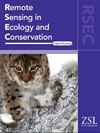ECOSTRESS衍生的半干旱森林温度和蒸散估算显示了干旱和间伐的影响
IF 4.3
2区 环境科学与生态学
Q1 ECOLOGY
引用次数: 0
摘要
美国西南部的森林正在经历越来越多的野火活动,土地管理者正在实施大规模的森林间伐处理。研究了半干旱黄松林间伐和区域干旱对ECOSTRESS地表温度(LST)和蒸散发(ET)的影响。我们在亚利桑那州北部研究地点的研究期间包括2019年的平均降水年,2020-2022年的区域干旱期,以及2023年创纪录的冬季降雪年。研究结果表明,春季是干旱季节,植物水分胁迫加剧。结果表明,ECOSTRESS LST数据对森林间伐、区域干旱及其相互作用较为敏感。与高分辨率无人机图像一致,ECOSTRESS LST数据表明,无论降水模式如何,稀疏森林的温度在多年间都显著升高。干旱期间,在疏林和非疏林中,ECOSTRESS的地表温度均升高(高达10°C),然后在2023年下降。ECOSTRESS ET对森林间伐和区域干旱同样敏感。与原位ET测量结果一致,ECOSTRESS ET在未疏林中显著大于疏林。干旱期间,两种森林的ECOSTRESS ET均显著降低。我们对EMIT数据的分析表明,EMIT趋势与地面高光谱数据不一致,地面高光谱数据记录的疏林水分含量大于非疏林。虽然质量滤波降低了ECOSTRESS数据的时间分辨率,但ECOSTRESS LST和ET数据都可以在大的空间范围内用于研究区域干旱和半干旱黄松林管理措施的影响。本文章由计算机程序翻译,如有差异,请以英文原文为准。
ECOSTRESS‐derived semi‐arid forest temperature and evapotranspiration estimates demonstrate drought and thinning impacts
Southwestern US forests are experiencing increasing wildfire activity, and land managers are implementing large‐scale forest thinning treatments. We investigated semi‐arid ponderosa pine forest thinning treatment and regional drought impacts on ECOSTRESS land surface temperature (LST) and evapotranspiration (ET). Our study period at a northern Arizona study site included an average precipitation year, 2019, a regional drought period of 2020–2022, and a record winter snowfall year 2023. We examined ECOSTRESS LST and ET during spring seasons when the region experiences an annual dry period, and plant water stress is heightened. Our results indicate that ECOSTRESS LST data are sensitive to forest thinning, regional drought and their interaction. Consistent with high‐resolution UAV images, ECOSTRESS LST data indicate the thinned forest had significantly greater temperature across years, regardless of precipitation patterns. During drought, ECOSTRESS LST increased in both thinned and non‐thinned forests (by up to 10°C) and then declined in 2023. ECOSTRESS ET was similarly sensitive to forest thinning and regional drought. Consistent with in situ ET measurements, ECOSTRESS ET was significantly greater in the non‐thinned forest compared to the thinned forest. ECOSTRESS ET significantly decreased during drought in both forests. Our analysis of EMIT data indicates that EMIT trends are not consistent with ground‐based hyperspectral data that documented thinned forest moisture content is greater than that of the non‐thinned forest. While quality filtering reduces ECOSTRESS data temporal resolution, both ECOSTRESS LST and ET data can be used across large spatial extents to examine impacts of regional drought and management treatments in semi‐arid ponderosa pine forests.
求助全文
通过发布文献求助,成功后即可免费获取论文全文。
去求助
来源期刊

Remote Sensing in Ecology and Conservation
Earth and Planetary Sciences-Computers in Earth Sciences
CiteScore
9.80
自引率
5.50%
发文量
69
审稿时长
18 weeks
期刊介绍:
emote Sensing in Ecology and Conservation provides a forum for rapid, peer-reviewed publication of novel, multidisciplinary research at the interface between remote sensing science and ecology and conservation. The journal prioritizes findings that advance the scientific basis of ecology and conservation, promoting the development of remote-sensing based methods relevant to the management of land use and biological systems at all levels, from populations and species to ecosystems and biomes. The journal defines remote sensing in its broadest sense, including data acquisition by hand-held and fixed ground-based sensors, such as camera traps and acoustic recorders, and sensors on airplanes and satellites. The intended journal’s audience includes ecologists, conservation scientists, policy makers, managers of terrestrial and aquatic systems, remote sensing scientists, and students.
Remote Sensing in Ecology and Conservation is a fully open access journal from Wiley and the Zoological Society of London. Remote sensing has enormous potential as to provide information on the state of, and pressures on, biological diversity and ecosystem services, at multiple spatial and temporal scales. This new publication provides a forum for multidisciplinary research in remote sensing science, ecological research and conservation science.
 求助内容:
求助内容: 应助结果提醒方式:
应助结果提醒方式:


